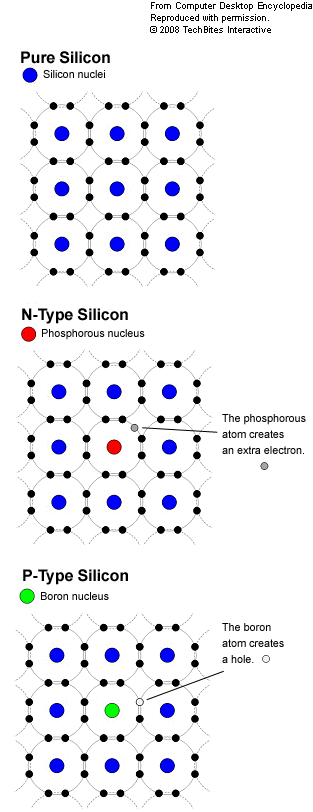
- •Unit 1 semiconductors
- •What is a semiconductor?
- •Types of semiconductors
- •Vocabulary
- •How semiconductors work
- •Doping of semiconductors
- •Vocabulary
- •Unit 2 diode
- •What is a diode?
- •Vocabulary
- •Creating a p-n junction
- •Types of diodes
- •Diode applications
- •Ionizing radiation detectors
- •Vocabulary
- •Unit 3 transistor
- •What does a transistor actually do?
- •Types of transistors and how they work
- •Vocabulary
- •Transistors in computers who invented the transistror?
- •Who Invented the Transistor?
- •Integrated circuit
- •What is an integrated circuit?
- •Vocabulary
- •How are integrated circuits made? who invented the integrated circuit?
- •Inside a Chip Plant
- •Vocabulary
- •Verbs with vowel changes
- •Verbs with 3 different vowels!
- •The really Irregular Verbs
- •Semiconductor glossary of terms
- •Unit 1 semiconductors
- •What is a semiconductor?
- •Types of semiconductors
- •Vocabulary
- •How semiconductors work
- •Doping of semiconductors
- •Unit 2 diode
- •What is a diode?
- •Vocabulary
- •Creating a p-n junction
- •Types of diodes
- •Vocabulary
- •Transistors in computers who invented the transistror?
- •Integrated circuit
- •What is an integrated circuit?
- •Vocabulary
- •How are integrated circuits made? who invented the integrated circuit?
- •Vocabulary
- •Bibliography
Doping of semiconductors
Start here
Part of this text is missing. Complete the sentences 1 – 10 with the phrases A – J. Use the information from the text about the types of semiconductors to help you. Put the verb “To be” in brackets in the correct form.
There (to be) ……………
Intrinsic semiconductors ………….
They (to be) ………………
Doping (to be) ……………
Extrinsic semiconductors ………………
Dopant (to be) ……………….
The materials chosen as suitable dopants …………
Dopants that produce the desired controlled changes (to be)
N-type semiconductors (to be) ……………
P-type semiconductors (to be) ……………
doped with acceptor impurities.
the process of deliberately introducing other elements into a crystal.
intrinsic and extrinsic semiconductors.
have good conductivity.
generally insulators.
the element introduced by doping.
classified as either electron acceptors or donors.
doped with donor impurities.
do not conduct electric current.
depend on the atomic properties of both the dopant and the material to be doped.
Find the synonyms to the adjectives: intrinsic and extrinsic.
Reading
Match the pictures in Fig. 1.4 with the descriptions 1-3.
Fig. 1.4. Crystal lattices of undoped (pure) and doped (p-type, n-type) semiconductors.
I
 t
is an extrinsic semiconductor which is obtained by doping the
impurity atoms of the V group in the periodic table of elements.
The impurity atoms added, provide extra electrons in the structure
and are called donor atoms. The electrons are majority carriers and
holes are minority carriers.
t
is an extrinsic semiconductor which is obtained by doping the
impurity atoms of the V group in the periodic table of elements.
The impurity atoms added, provide extra electrons in the structure
and are called donor atoms. The electrons are majority carriers and
holes are minority carriers.Each circle represents a silicon atom, and the lines between the atoms represent the shared electrons. Each of the four valence electrons in each silicon atom is shared with one neighboring silicon atom. Thus, each silicon atom is bonded with four other silicon atoms.
It is an extrinsic semiconductor which is obtained by doping the impurity atoms of the III group in the periodic table. The impurity atoms added, create holes in the structure and are called acceptor atoms. The holes are majority carriers and electrons are minority carriers.
Listening
Listen to the text and do the tasks below.
When voltage is applied to either an N-type or a P-type semiconductor, current flows, for the same reason that it flows in a regular conductor. The negative side of the voltage pushes electrons, and the positive side pulls them. The result is that the random electron and hole movement that's always present in a semiconductor becomes organized in one direction, creating measurable electric current.
Holes move more slowly than electrons. When electrons move in one direction, holes move in the opposite direction. This is like cars parked along a street. If one car moves to an empty slot, the empty slot moves the other way. The cars move to the right, the empty slot to the left. A solitary electron in the presence of a solitary hole will recombine. Only electrons and holes which are free, and hence have not recombined, play a role in electrical conduction.
Even in a highly doped p-type semiconductor there will always be some free electrons. Similarly, n-type semiconductors always contain some holes. The predominant mobile charge carriers are called majority carriers, whilst those in the minority are called minority carriers. For example, the majority carriers in n-type material are free electrons.
Study the energy band structures of intrinsic and extrinsic semiconductors in Fig. 1.5.

Fig. 1.5. Energy band structures of undoped (pure) and doped (n-type, p-type) semiconductors.
Make a comparative table of an N-type and a P-type semiconductor. Use the information in the previous tasks.
Types of extrinsic semiconductors
N-type semiconductor |
P-type semiconductor |
|
Majority charge carriers |
||
|
|
|
Minority charge carriers |
||
|
|
|
Group of the impurity atoms in the periodic table of elements |
||
|
|
|
Impurities are called |
||
|
|
|
Extra energy level |
||
|
|
|
Fermi level lies in between |
||
|
|
|
